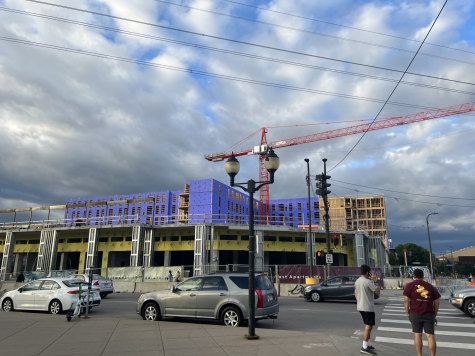Is All the Dinkytown Construction Worth It?
September 21, 2022

 I can barely remember a time when Dinkytown wasn’t buried beneath a sea of construction sounds and debris. It was the first semester of my freshman year. Opportunity was ripe and with the ability to get two McChickens from the McDonald’s in Dinkytown at 1AM on any given night of the week, I felt unstoppable. That was, until it was torn down to accommodate a new student apartment building. I hope to answer the question: is all this construction worth it?
I can barely remember a time when Dinkytown wasn’t buried beneath a sea of construction sounds and debris. It was the first semester of my freshman year. Opportunity was ripe and with the ability to get two McChickens from the McDonald’s in Dinkytown at 1AM on any given night of the week, I felt unstoppable. That was, until it was torn down to accommodate a new student apartment building. I hope to answer the question: is all this construction worth it?
It seems as though a new student housing facility opens up almost every year with the Uncommon opening in 2020 and now The Doyle opening this year, 2022. Continuing on this trend, an additional seven-story commercial and residential building developed by CA Ventures is slated to open in 2023 and an additional 17-story building is set to break ground within the next 12 months.
While the two latest openings – Uncommon and The Doyle – boast unit counts of 114 and 81 respectively, the two upcoming Dinkytown additions are targeting sizes of over 300 units. When they open within the next few years they will provide housing for an additional 1,600 students. This begs the question, will the University of Minnesota have 1,600 more students by the 2025 school year to reside in these new complexes?
New student undergraduate enrollment has hit an all-time high this fall with 6,840 new undergraduates – up steadily from 5,324 in 2011. Interestingly enough, the 10-year average of undergraduate enrollment is 28,574 while the current enrollment for this school year is 28,575. Despite the rise in incoming freshmen each year, there’s been a negligible increase in overall undergraduate enrollment. Because of this, it’s unreasonable to expect an overall increase of 1,600 undergraduates within the next couple years.
Next, looking at graduate students, there’s been a 10-year average of 9,762 students enrolled full-time compared to the 9,608 enrolled this fall. Barring a complete turnaround in this trend, it’s hard to imagine it will be graduate students filling these new housing facilities either. So, who will?
Well for the survival of these new housing facilities – and the businesses that surround them – we better hope their new tenants aren’t students. These new complexes have claimed parcels of land that were once home to thriving Dinkytown businesses, and most notably, parking lots that made these businesses more accessible to commuters.
Cane’s franchisee and Vice President of the Dinkytown Business Alliance, Kent Kramp says, “Businesses that have found success have a continuous stream of business, even when the students leave.” He describes that the first year attrition of new businesses around the University is nearly 90%, with only 20% of the survivors making it long-term.
The cost of being a student has increased steadily in almost every way in recent years. Average rent costs have risen 14% nationally in the last year. The average cost of textbooks has risen almost 90% in the last 15 years. Average tuition costs have grown 158% at public universities since 2001. The average amount of student debt at their time of graduation has nearly doubled in the last 20 years. Students don’t have the means to be the primary supporters of businesses around a college campus.
Alison Kirwin – owner of Dinkytown staple Al’s Breakfast – says, “Students only have so much money. If you’re assuming that 5,000 students are going to eat here every day because they live in the area, that’s a huge overestimation.” adding that her older customers are the ones with the disposable income.
With these new housing options presumably targeting prices out of many students’ reach, their primary hope of filling their units will reside with recent university graduates. While it’s the goal of many to give recent graduates reasons to stick around the Twin Cities, the very fate of Dinkytown might truly depend on it.












Jordan • Oct 6, 2022 at 10:48 pm
McDonald’s is planning to open a new location there once construction is done, and it will be a whole lot nicer than the old one. Good to have lots of good housing options right next to the U so students don’t have to travel so far between home and campus. Abundance of housing units also ensures that rents don’t skyrocket like they have in many other cities!